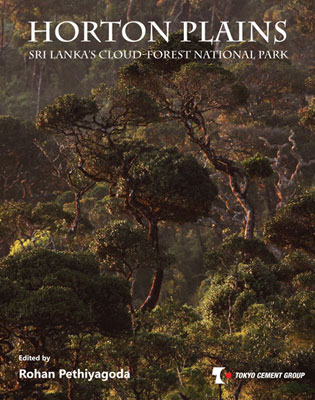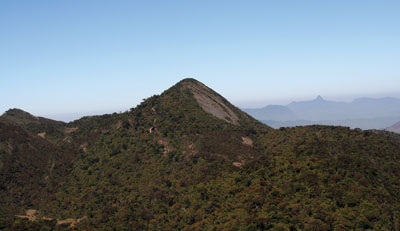The book begins with 'A personal note' where the author relates his early experiences in the Plains as they were in the 1960s and '70s and the subsequent changes brought about by increased visitation and management. It brings into focus one of the dilemmas of enjoying nature. Should nature appreciation be the preserve of a lucky (or privileged) few or should it be enjoyed by the masses? On the one hand, if it is restricted to a minority, why should the majority be interested in conserving it?
On the other, don't masses of merrymakers trampling across the landscape destroy the very things that make 'unspoilt' nature dear: the tranquility, the peace, the purity? I myself treasure the hikes I did to Horton Plains in my distant youth, on the "Ohiya short-cut", from Bogawantalawa along the old bridle path, and from Belihul-Oya. Unfortunately these treks to the Plains are no longer allowed now that the site is a National Park, which is a pity. It denies the youth of today sterling experiences that lead to a greater appreciation of nature.
 |
Chapter 1 of the book relates the history of the Plains, and its 'discovery' by westerners. It traces the colourful histories of Lord Horton and Samuel Baker who left their mark not only on the history of Sri Lanka but also globally. The chapters excerpt from Baker's 'The Rifle and Hound in Ceylon', Haeckel's 'A Visit to Ceylon' and Forbes' 'Eleven years in Ceylon' provide a glimpse into the Plains and its environs in 19th century Ceylon, garnishing an already delectable tale of the history of the Plains that is well researched and presented.
The descriptions of the surrounding environs of the Plains by these early writers especially of Nuwara Eliya and Hakgala bring a sense of melancholy when considering the state of these places today. The chapter gives a valuable historical presence to the Plains giving it character. Again I must bemoan the fate that has befallen the Farr Inn of yore, a place with such atmosphere and history, turned into an aseptic "visitor centre" by the Plains' guardians of today.
Chapter 2 "Landscape" brings us stunning vistas of the Plains from every conceivable angle and elevation. The high resolution satellite imagery provides a unique overall perspective of the Plains. Rohan's succinct description nicely summarizes the physiognomy of the area. In the next chapter "Cloud forest", Professor Savitri Gunatilleke joins Rohan to explain the intricacies of this unique type of montane vegetation, its form and function, its importance, and variants in Sri Lanka and globally. The chapter is a treat for all plant lovers, richly illustrated with colourful photographs of rare and exotic blooms.
The discussions on why the canopy flushes red and the serious forest dies back will hopefully catch the attention of a budding researcher who may go on to make discoveries that will unravel these mysteries. The comprehensive account of nillu (Strobilanthes) with some excellent photographs displaying not only their characteristics but also the beauty, is an achievement by itself. The description of the lichens of Horton Plains provides us a window to a little known and appreciated group of organisms. The discussion on the prehistory of the Plains, the major changes in land cover associated with changing global conditions over millennia, and its possible use by humans dating back to around 13,000 years ago rounds up an intriguing chapter.
The chapter 'Grassland' by Professor Nimal Gunatilleke and Rohan brings to the fore the debate on the origin of grasslands in tropical areas and the hand of man in their genesis. The comprehensive discussion presenting information from a series of studies dating back to British times concludes that "the most compelling explanation for the origin of Horton Plains grasslands remains historical burning" and goes onto discuss the possible implication of fire prevention in today's context of aggressive alien invasive plants. However, it begs the question of whither Horton Plains, if in a hundred years succession converts the grassland into forest? The discourses on plants that eat animals and rhododendrons so emblematic of the Plains, are authoritative but as easy to read as a novel. The description of brambles gently introduces the uninitiated to the thorny question of systematics with nary a scratch. The array of beautiful pictures provides a comprehensive and absorbing view of grassland flora.
Chapter 5 immerses the reader in the diversity and intricacies of the aquatic habitats of the Plains. Here we learn of the water plants, the fresh water crabs, the shrimp with the delightful name of Lancaris singhalensis that managed to hold out against the rainbow trout introduced by the British: in yet another example of human yearnings for familiarity and the disaster it has spelt for countless ecosystems the world over.
'Landsnails' by Dr. Dinarzarde Raheem presents the diversity and wonders of this barely known fauna, to the accompaniment of an array of pictures compelling one to appreciate (if reluctantly!) the irrefutable beauty of a snail! Though brief, it leaves one wondering about the lives and ecology of the different species. Nancy van der Poorten's description of the dragons and damsels of the Odonata provides a detailed account of their life history, including a graphic description of their gymnastics of procreation.
The photographs bring to the living room these living jewels which are said to be 'superb predators' giving an all new meaning to 'beauty and the beast'! Gehan's de Silva Wijeyeratne's pearls of wisdom as to the spots to observe these wonders and the list of dragonflies observed in the Plains are impressive. It will be much valued by all 'dragonfly watchers' a new breed of nature-lover, which will no doubt proliferate in the future with efforts such as his, of popularizing this fascinating pasttime. Dr Michael van der Poorten's authoritative account on the array of butterflies that grace the Plains is well supported by a comprehensive set of photographs that will allow the uninitiated to take up the absorbing hobby of 'butterfly watching'.
 |
| Scenic view of Kirigalpotta and Siri Pada from the Plains |
In chapter 9, Dr Madhava Meegaskumbura and Kelum Manamendra-Arachchi join Rohan to describe the Amphibian fauna of the plains. As the group that planted Sri Lanka firmly on the global amphibian map, they live up to expectations, providing us with intimate details of the lives of these elusive characters including identification points, different habits of the varied species and where they can be observed. The fascinating photographs and descriptions of the breeding strategies of Sri Lankan shrub frogs no doubt will give a glimpse to a wide audience of the wonders of nature that we are blissfully unaware of on our daily grind. 'Reptiles' by Rohan and Sudath Nanayakkara, one of the principal photographers, introduces us to the variety of snakes and lizards of the Plains. Again the pictures depict these seldom seen fauna in unmistakable light. The discourse on why some animals have horns introduces the reader gently to some of the most intriguing questions in natural science, such as sexual selection and reproductive strategies.
'Birds' by Gehan and Rohan take us through the avifauna of the Plains. Some of the pictures here are breathtaking. Gehan's discussion on bird watching gives valuable pointers on how and where to see some of the celebrated endemics. Habits and habitats, residents, migrants, endemics, common, rare and vagrants are all described adding to an already overburdened 'to do' and 'to see' list on our next visit to the Plains.
In chapter 12 (Mammals) Rohan and Dr Suyama Meegaskumbura give excellent and detailed accounts of the mammalian fauna of the Plains. From the highland slender loris which has but been glimpsed only a handful of times, to the sambur herds which populate the Plains, we are provided much information that is interesting and captivating. The notes on the many species of shrews provide an in- depth look at a hitherto little known group of mammals. In 'elephants' is finally found a minute error (what a relief!) where it is stated that elephants have disappeared altogether from the highlands. At least 15-20 individuals still persist in the Peak wilderness but, of course, none are in the Plains as the book points out. Jayantha's Jinasena's paintings, done in a style reminiscent of illustrations of yore, add much charm to the book.
In the final chapter 'Conservation' Rohan pulls it all together and discusses the variety of threats facing the survival of the Plains and what could be done about it. It brings to the fore many questions on what we mean by conservation, what the priorities should be and what we must do to achieve them. Clearly 'protection' is not synonymous with 'conservation'. Conservation requires sound scientific knowledge, on which management plans are based and implemented with careful monitoring and feeding back of findings or adaptive management.
That we are far from being able to achieve such ideals is clear. Whether we as a country will ever achieve such a state and if some time in the distant future such a day dawns, what will be left to conserve of the wonders chronicled in this text is something to ponder.
Rohan is well known as a pioneer in nature publication in Sri Lanka. His ground-breaking book on freshwater fishes set a new standard in nature publication over two decades ago. His 'Journal of South Asian Natural History' and 'Sri Lanka Nature' led to a revolution in the field of nature periodicals in the region. With 'Horton Plains' he has once again raised the bar, engendering a new genre of nature publication. He has to be praised for resisting the temptation to write it in the form of a guide book, instead taking the trouble and effort to cite the scientific works which have provided many insights.
'Horton Plains' sets a new standard, blending serious science with the beauty of simple nature appreciation to bring forth a tome that is scientifically sound as it is aesthetically pleasing. The photographs depicting some of the rare and seldom seen taxa are breathtaking not only for their recording, but also from an artistic point of view. Whoever thought a female Jungle Fowl could be such a statuesque beauty! In 'Horton Plains' Vimukthi Weeratunga and a host of other very competent photographers provide us with an unforgettable experience through their lenses, that is in many cases better even than being there.
The valuable contributions from a group of well established scientists add further value to the book. Truly a labour of love, 'Horton Plains' is that rare find which comes along but once in blue moon. Lovers of nature would do well to avail themselves of the prepublication offer at www.books.lk. |
